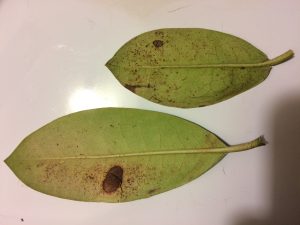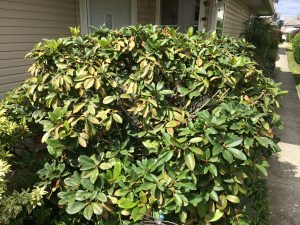As frequently happens, I get interrupted from my tasks to attend to strata owners’ requests. Today was a statutory holiday in British Columbia so we hit the site with a California-style mow-blow-go service. Of course, this also meant that residents who would normally be at work were home.
And off we went to see the lady’s front entrance rhododendron. The owner said it’s been suffering with white flies for five seasons. She gives it fertilizer and prunes it twice a year to keep the height in check. It doesn’t flower much. Aha, I could feel a blog post brewing in my head.
Bugs on leaf undersides
I examined the leaf undersides but found lace bugs instead of white flies. Since both bugs are sucking insects I knew sprays are usually employed to control them. So I snapped a few photos and made a note to do some research when I got home. I’m also fortunate to have great contacts to reach out to when I need help. One is municipal gardener Tracey Mallinson and another is Dr. Linda A. Gilkeson.
Rhodo
Let’s examine the rhododendron. It appears to be in too-sunny a location. Rhododendrons in shadier spots don’t suffer as many infestations. This goes for Azaleas and Pieris japonicas.
The shrubs looks OK from distance but the insect damage is obvious up close. Flipping the leaves upside down, it was easy to spot the lace bugs. The Pieris japonica on the left is also affected.
I have no idea how much rhododendron fertilizer the plant gets but I’m assuming the owner follows the label. Another suggestion online was to keep the roots moist.
The owner prunes the rhodo twice a year to keep its height in check. She enjoys the privacy she gets but doesn’t want to be overwhelmed. This made me think of Japanese gardeners who refuse to prune trees and shrubs that show signs of weakness. Instead they ask the owner to nurse the plant back to health.
Solutions
Best course of action in July would be direct forceful blasts of water on the underside of leaves. I’m sure there are commercial insecticidal sprays but once you go the chemical route you’re stuck. Dr. Gilkeson states that the sprays must be repeated 10-14 days later and there is some danger that the sprays could burn the leaves. We don’t have that problem with water; water is also considerably cheaper.
The best solution would be for natural predators to arrive and feast on the lace bugs. Patience!








